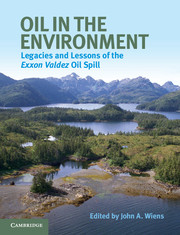Book contents
- Frontmatter
- Contents
- List of contributors
- Use of acronyms
- Acknowledgments
- A bibliographic note
- Prologue
- Part I Introduction and background
- Part II Oil in the environment
- Part III Biological effects
- 9 Cytochrome P450 1A (CYP1A) as a biomarker in oil spill assessments
- 10 Assessing effects and recovery from environmental accidents
- 11 Shoreline biota
- 12 Oiling effects on pink salmon
- 13 Pacific herring
- 14 Oil and marine birds in a variable environment
- 15 Sea otters: trying to see the forest for the trees since the Exxon Valdez
- Part IV Assessing oil spill effects and ecological recovery
- Part V Conclusions
- Index
- References
12 - Oiling effects on pink salmon
Published online by Cambridge University Press: 05 July 2013
- Frontmatter
- Contents
- List of contributors
- Use of acronyms
- Acknowledgments
- A bibliographic note
- Prologue
- Part I Introduction and background
- Part II Oil in the environment
- Part III Biological effects
- 9 Cytochrome P450 1A (CYP1A) as a biomarker in oil spill assessments
- 10 Assessing effects and recovery from environmental accidents
- 11 Shoreline biota
- 12 Oiling effects on pink salmon
- 13 Pacific herring
- 14 Oil and marine birds in a variable environment
- 15 Sea otters: trying to see the forest for the trees since the Exxon Valdez
- Part IV Assessing oil spill effects and ecological recovery
- Part V Conclusions
- Index
- References
Summary
Introduction
Alaskan salmon are of major sport and commercial importance, figure importantly in the traditions and livelihood of native cultures, and support food webs for an array of carnivores and scavengers. Of the five Pacific salmon species, pink salmon (Oncorhynchus gorbuscha) are the most abundant in Prince William Sound (PWS). Annual harvests yield 20–70 million adult pink salmon, with a value that averaged over $29 million annually between 2001 and 2010 (Fig. 12.1). The subsistence and commercial importance of the pink-salmon fishery, combined with the overlap of the 1989 Exxon Valdez oil spill with the early life stages of the salmon, make understanding the effects of the spill both critical and challenging.
Following the spill, the commercial pink-salmon fishery was closed. In addition, an Oil Spill Health Task Force was organized to ensure the safety of subsistence foods. The Task Force used analytical data on hydrocarbons in pink salmon (and other subsistence foods) (Field et al., 1999) and determined that there were no Exxon Valdez polycyclic aromatic hydrocarbons (PAH) in sampled edible salmon tissues in 1989 and 1990.
- Type
- Chapter
- Information
- Oil in the EnvironmentLegacies and Lessons of the Exxon Valdez Oil Spill, pp. 263 - 291Publisher: Cambridge University PressPrint publication year: 2013
References
- 1
- Cited by

